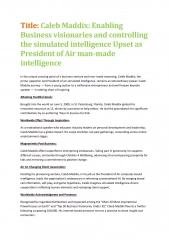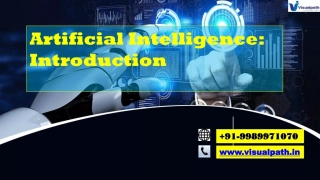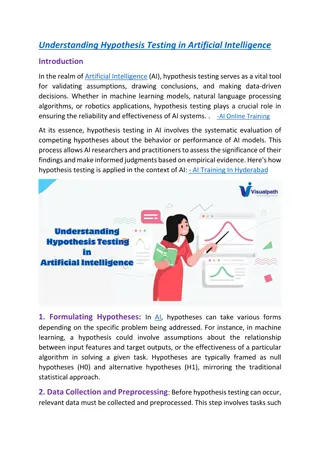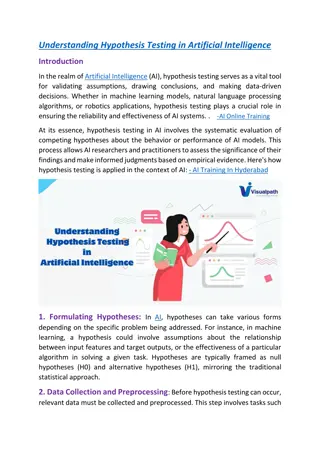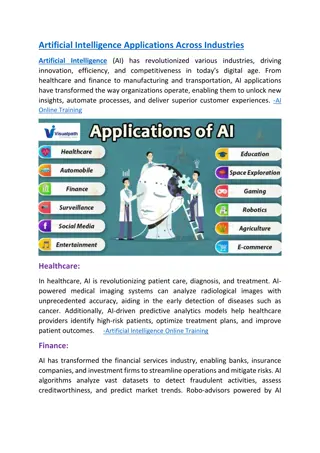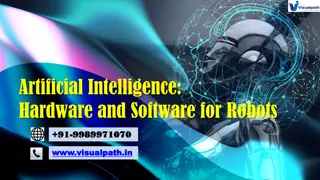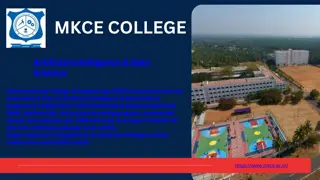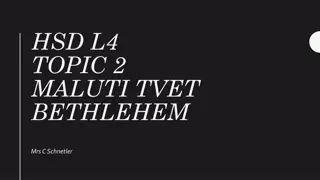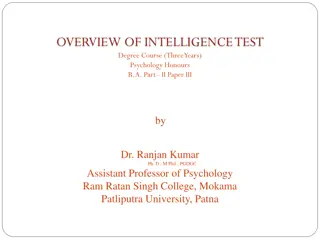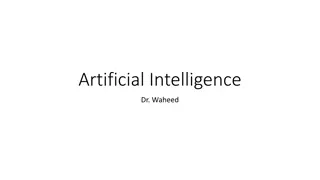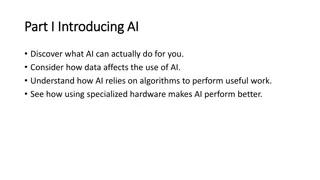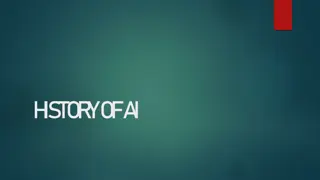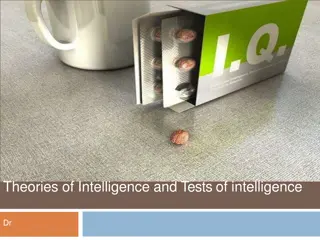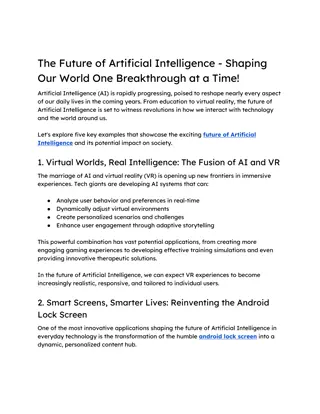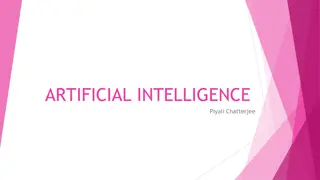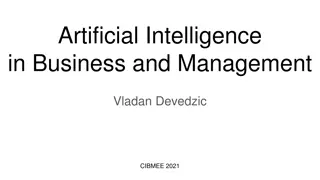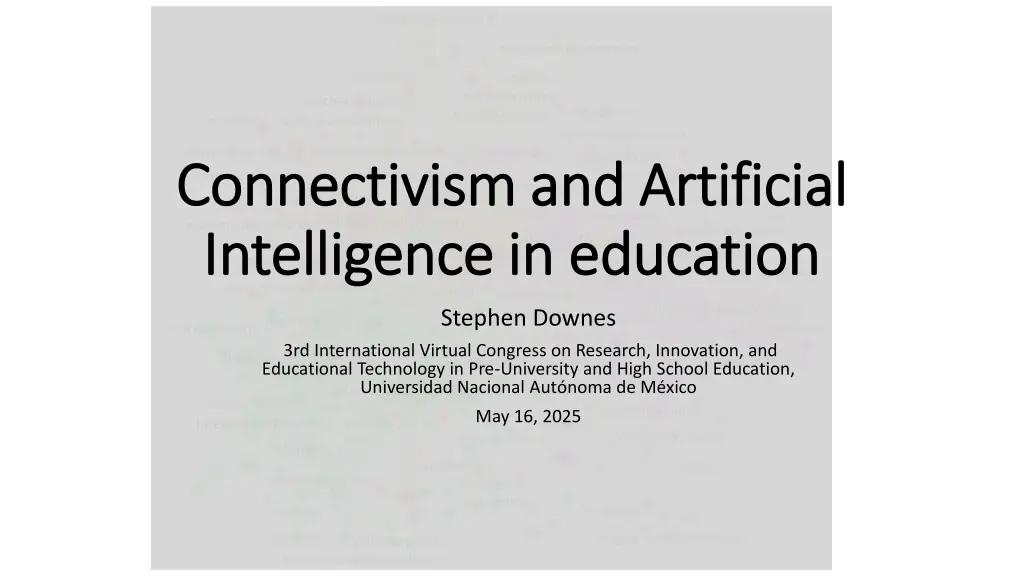
Role of AI in Education and Its Connection to Connectivist Learning Theories
Explore the role of artificial intelligence (AI) in education and its relation to Connectivist learning theories. Delve into AI's capabilities like personalized learning and its potential impact on the educational landscape, while also considering current gaps in leveraging AI effectively for critical thinking and community building in learning environments.
Download Presentation

Please find below an Image/Link to download the presentation.
The content on the website is provided AS IS for your information and personal use only. It may not be sold, licensed, or shared on other websites without obtaining consent from the author. If you encounter any issues during the download, it is possible that the publisher has removed the file from their server.
You are allowed to download the files provided on this website for personal or commercial use, subject to the condition that they are used lawfully. All files are the property of their respective owners.
The content on the website is provided AS IS for your information and personal use only. It may not be sold, licensed, or shared on other websites without obtaining consent from the author.
E N D
Presentation Transcript
Connectivism and Artificial Connectivism and Artificial Intelligence in education Intelligence in education Stephen Downes 3rd International Virtual Congress on Research, Innovation, and Educational Technology in Pre-University and High School Education, Universidad Nacional Aut noma de M xico May 16, 2025
What is the role of AI in education and its connection to Connectivist learning theories? Connectivism https://www.downes.ca/post/73314 Cover image: https://www.mdpi.com/2227-7102/15/3/368 https://files.eric.ed.gov/fulltext/ED572896.pdf
The Robot Tutor In which I discuss the idea of AI as delivering personalized learning Knewton (2015) https://www.wired.com/2015/08/knewton-robot-tutor/ Pearson (2016) https://eliterate.us/pearsonalized-learning/ Robot Academy https://robotacademy.net.au/ Khanmigo - https://www.khanmigo.ai/learners Professor tailored AI tutor to physics course (2024) https://news.harvard.edu/gazette/story/2024/09/professor-tailored-ai- tutor-to-physics-course-engagement-doubled/ ProfBot (2025) https://www.downes.ca/post/77500/rd
The Robot Tutor What AI can do (if imperfectly, for now) AI can write instructional materials AI can help you answer questions AI can evaluate your work AI can create adaptive instruction It can help administrate learning https://education.illinois.edu/about/news- events/news/article/2024/10/24/ai-in-schools--pros-and-cons
The Robot Tutor What we re not using it for (right now) Posing alternatives or raising questions Fostering critical thinking and personal reflection Stimulating or facilitating discussion Building community Generate student activities Work on the cognitive skills to be developed https://www.tonybates.ca/2025/05/09/an-evaluation-of-contact-norths-ai-tools-for- teachers-instructors-learning-shorts/
Personal vs Personalized Learning Where do we want learning to go? https://www.downes.ca/presentation/497
Personal vs Personalized Learning The idea of personal learning: Based on learner projects, needs or interests Learning results from practice more than instruction Pedagogy of support rather than evaluation Tools designed to build capacity Combine the idea of personal learning + online course to create the MOOC
The MOOC Massive by design Open gratis and libre Online not blended, not wrapped Courses not communities, websites, video collections, etc https://www.downes.ca/presentation/336 Image: Gordon Lockhart http://gbl55.wordpress.com/2011/03/08/cck11-man-this-mooc-is-something-else/
The MOOC And the idea of learning as self-organizing learning communities These are at once perceptual systems and reasoning systems
The MOOC Design principles Openness - Open access - Open content - Open activities - Open assessment Autonomy - Choice of contents - Personal learning - No curriculum Diversity - Multiple tools - Individual perspective - Varied content Interactivity - Encourage communication - Cooperative learning - Emergent knowledge
Connectivism Connectivism is the thesis that https://www.downes.ca/presentation/547 knowledge is distributed across a network of connections, and therefore that learning consists of the ability to construct and traverse those networks. To know something is to be organized in a certain way To learn is to become organized in that way
Connectivism Things that learn Personal Learning Social Learning (Polanyi) (Wittgenstein)
Connectivism How we learn Hebbian rules - 'what fires together wires together' Contiguity - neurons that are located near each other connect Back Propagation - signals sent in reverse direction through a network, aka 'feedback', modify connections created by forward propagated signals Boltzmann - networks seek to attain the lowest level of kinetic energy The actual physical descriptions of these theories vary from network to network.
Distributed Representation Concepts in a network https://www.downes.ca/presentation/144 Distributed Representation = a pattern of connectivity stands for? Or is caused by?
Distributed Representation What we learn The Classical Realization of Quantum Parallelism http://brainworkshow.sparsey.com/tag/sparse-distributed-representations/
Connectionism Neural networks and artificial neural networks https://ethics.mooc.ca/cgi-bin/page.cgi?presentation=59 https://www.youtube.com/watch?v=JrXazCEACVo
Connectionism Regression Feature detection Clustering Prediction What does AI actually do? A neural network is ultimately a statistical function, but one that manages tens of thousands of input variables An AI model defines those values: what they are, and how they re determined
Connectionism Weights, values and biases One node in a larger network
Pattern Recognition What does it mean to say knowledge is the set of connections ? When presented with phenomena, this pattern, rather than that pattern, is activated
Pattern Recognition To know is to recognize To 'know' that 'A is B' is to 'recognize' that 'A is B', that is, when presented with 'A', one reacts as though being presented with a 'B'. Recognition lies at the core of communication, as it allows (for example) a symbol 'tiger' to suggest a phenomenon (a tiger). What is important to understand here is that the recognition is something the *recipient* brings to the table. It is not inherent in the presentation of the phenomenon, and may not even be intended by the presenter (indeed, as likely as not, the presenter had something different in mind). https://www.downes.ca/post/57746
Projection Game What word comes next? Bacon and _____
Projection Game What word comes next? Bacon and _eggs_ Wayne _____
Projection Game What word comes next? Bacon and _eggs_ Wayne _Gretzky_ American ______
Projection Game What word comes next? Bacon and _eggs_ Wayne _Gretzky_ American _Idol_ Justin _______
Projection Game What word comes next? Bacon and _eggs_ Wayne _Gretzky_ American _Idol_ Justin _Trudeau_ Tried and _____
Projection Game What word comes next? Bacon and _eggs_ Wayne _Gretzky_ American _Idol_ Justin _Trudeau_ Tried and _true_
Knowledge Three kinds of knowledge http://teachweb2.blogspot.com/2008/09/cck08-knowledge-concept-map.html
Knowledge Connective knowledge is emergent Recognized by network Emerges from data Based on previous experiences shaping the network
Knowledge Our detailed understanding of development in LLMs can allow us to probe specific questions about human development. The distinction between meaning itself, and representations of meaning encoded in language, is a crucial element of over a century of work in semiotics. This work argues that meaning is derived from the interpretation of mappings between signs (forms) and signifiers (e.g., Peirce, 1977; Saussure, 1983; similar to Bender & Koller s definition of meaning). Signifiers are things in the world that we are familiar with through embodied experience. LLMs do not have access to signifiers; they only have access to written linguistic forms https://direct.mit.edu/opmi/article/doi/10.1 162/opmi_a_00160/124234/The-Limitations- of-Large-Language-Models-for
Knowledge Learning from experience Learning as an active process Learning is continuous and iterative Engage dynamically with real-world challenges not passively absorbing Knowledge is acquired through hands-on participation in practical activities Activities such as simulations, fieldwork, and case studies immerse students in authentic learning experiences Experience-based engagement Structured reflection, analyze experiences and extract insights Critical thinking, assess situations, adapt, and make informed decisions Reflection and Critical Thinking Knowledge is tested and refined through active experimentation Students apply theoretical concepts to practical contexts, reinforcing understanding through trial and revision Application and Experimentation Kolb s Experiential Learning Theory (1984) https://feedbackfruits.com/blog/bridging-theory-and-practice-with-experiential-learning
Learning Communities Learning as a part of a community Being part of a community that learns Wenger: domain, community, practice (aspects of CoP here finding, connecting, creating ) engaging in activities of mutual interest (finding), building relationships through shared activity (connecting) creating common resources https://doi.org/10.1002/bmb.20548 Compare with how we train an AI
Learning Communities https://www.tonybates.ca/2014/10/01/the-role-of-communities-of-practice-in-a-digital-age/ https://opentextbc.ca/teachinginadigitalage/chapter/6-7-experiential-learning/
Learning Communities Empowering communities using artificial intelligence Co-designing AI systems with local communities Collecting and explaining community data using AI Adapting AI systems to long-term social changes https://pmc.ncbi.nlm.nih.gov/articles/PMC9058901/
Personal Learning Environments A network of personal learning environments creates a borderless MOOC http://x28newblog.blog.uni-heidelberg.de/2008/09/06/cck08-first-impressions/
Personal Learning Environments Creating our own data and learning networks http://www.downes.ca/post/58150 http://dmlcentral.net/blog/howard-rheingold/diy-u-interview-anya-kamenetz
Personal Learning Environments The prototypical model https://www.je-lks.org/ojs/index.php/Je-LKS_EN/article/view/29
Personal Learning Environments My approach Social Network Social Network Writing Space Blogs Blog Post Articles List of references Article
Personal Learning Environments Clist https://ple.mooc.ca
Core Skills Data/AI literacy models Data stewardship model Analysis and decision-making model Information literacy model Science and research data literacy model Social engagement model https://www.downes.ca/cgi-bin/page.cgi?presentation=574
Core Skills Activities and inspiration Consider the broader implications & thoughtful use Preserve learning and authentic voice Embrace play and experimentation Practice strategic iteration https://creativecomputing.gse.harvard.edu/genai/
Thank you Stephen Downes https://www.downes.ca

